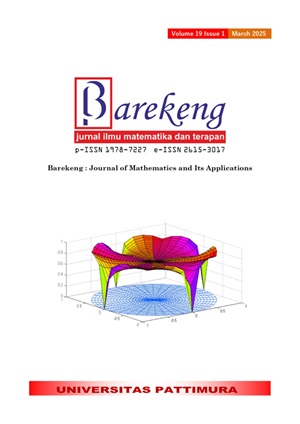BINARY OPTION PRICING USING LATTICE METHOD
Abstract
One way to minimize risks due to uncertainty in stock price movements is by using derivative products, one of which is an option. Binary options, a type of exotic option, provide a fixed payout if certain conditions are met at maturity, but are difficult to solve analytically. In this study, we utilize binomial and trinomial lattice methods, specifically the Cox-Ross-Rubinstein Binomial, Hull-White Trinomial, and Kamrad-Ritchken Trinomial models, to determine the price of binary options. Results indicate that all three methods converge towards the exact solution, demonstrating their applicability for pricing binary options, with the Kamrad-Ritchken Trinomial method showing superior accuracy due to the lowest mean relative error. Additionally, we analyze factors influencing binary option prices, including initial price, strike price, maturity time, volatility, and risk-free interest rate. The study’s originality lies in the comparative analysis of these methods under the same market conditions. However, limitations include model assumptions and potential data variability that may affect generalizability. Future research could extend these methods to various stock data or other financial instruments to test robustness. This research provides insights into optimal lattice method selection for practitioners in binary option pricing.
Downloads
References
D. C. Lesmana et al., “Perbandingan Harga Opsi Reset dengan Metode Monte Carlo Standar dan Control Variate,” Limits: Journal of Mathematics and Its Applications, vol. 20, no. 3, p. 327, Nov. 2023, doi: 10.12962/limits.v20i3.17053.
I. Kamila, E. H. Nugrahani, and D. C. Lesmana, “Metode Monte Carlo untuk Menentukan Harga Opsi Barrier dengan Suku Bunga Tak Konstan,” MILANG: Journal of Mathematics and Its Applications, vol. 16, no. 1, pp. 55–68, 2017.
F. Zubedi, N. Achmad, S. L. Mahmud, and R. Mowuu, “Penentuan Harga Beli Opsi Asia Menggunakan Monte Carlo-Antithetic Variate dan Monte Carlo-Control,” Euler : Jurnal Ilmiah Matematika, Sains dan Teknologi, vol. 10, no. 1, pp. 7–14, Apr. 2022, doi: 10.34312/euler.v10i1.12055.
Y. Yang, F. Soleymani, M. Barfeie, and E. Tohidi, “A radial basis function — Hermite finite difference approach to tackle cash-or-nothing and asset-or-nothing options,” J Comput Appl Math, vol. 368, Apr. 2020, doi: 10.1016/j.cam.2019.112523.
S. Febrianto, “Perbandingan Penggunaan Metode Binomial dan Trinomial pada Penentuan Harga Opsi Bermuda,” IPB University, Bogor, 2023.
J. Ma and T. Zhu, “Convergence rates of trinomial tree methods for option pricing under regime-switching models,” Appl Math Lett, vol. 39, pp. 13–18, 2015, doi: 10.1016/j.aml.2014.07.020.
John. C. Hull, Options, Future, and Other Derivatives, 11th ed. New Jersey: Pearson Education International, 2021.
S. Sulastri, L. Novieyanti, and S. Sukono, “Penentuan Harga Opsi Barrier Menggunakan Metode Trinomial Kamrad-Ritchken Dengan Volatilitas Model Garch,” JURNAL ILMU MANAJEMEN DAN BISNIS, vol. 10, no. 1, pp. 83–92, Mar. 2019, doi: 10.17509/jimb.v10i1.16163.
C. Chalimatusadiah, D. C. Lesmana, and R. Budiarti, “Penentuan Harga Opsi Dengan Volatilitas Stokastik Menggunakan Metode Monte Carlo,” Jambura Journal of Mathematics, vol. 3, no. 1, pp. 80–92, Apr. 2021, doi: 10.34312/jjom.v3i1.10137.
J. C. Hull, Options, Future, and Other Derivatives, 11th ed. New Jersey: Pearson Education International, 2021.
Syarifah Nadia, Evy Sulistianingsih, and Nurfitri Imro’ah, “PENENTUAN HARGA OPSI TIPE EROPA DENGAN METODE BINOMIAL,” Bimaster : Buletin Ilmiah Matematika, Statistika dan Terapannya, vol. 7, no. 2, pp. 127–134, 2018.
V. Maulida, E. Siswanah, and E. K. Nisa, “Penentuan Harga Opsi Tipe Eropa dengan Model Binomial,” Square : Journal of Mathematics and Mathematics Education, vol. 1, no. 1, p. 65, Sep. 2019, doi: 10.21580/square.2019.1.1.4111.
W. Wahyuni and D. Ekawati, “Perbandingan Harga Opsi Put Tipe Eropa Menggunakan Metode Binomial dan Trinomial,” Jurnal Sains Matematika dan Statistika, vol. 10, no. 1, p. 85, Mar. 2024, doi: 10.24014/jsms.v10i1.20504.
A. Meliana Situmorang, M. Dayani Adinata, L. Rahman Adrell, M. Andias Putra Ramadhani, L. Noviyanti, and E. Harin Widhastika, “Penentuan Harga Opsi Put Amerika dengan Metode Trinomial Kamrad Ritchken Harga Saham Penutupan BBCA,” BIAStatistics Journal Of Statistics Theory And Application, vol. 2024, no. Special Issue, pp. 168–179, 2024.
D. Odhiambo Ogot, “An Adjusted Trinomial Lattice for Pricing Arithmetic Average Based Asian Option,” American Journal of Applied Mathematics, vol. 6, no. 2, p. 28, 2018, doi: 10.11648/j.ajam.20180602.11.
Ermawati, P. Rahayu, and F. Zuhairoh, “Perbandingan Solusi Numerik Integral Lipat Dua pada Fungsi Aljabar Dengan Metode Romberg dan Simulasi Monte Carlo,” Jurnal Matematika dan Statistika serta Aplikasinya, vol. 5, no. 1, p. 46, 2017.
D. C. Lesmana and S. Wang, “A numerical scheme for pricing American options with transaction costs under a jump diffusion process,” Journal of Industrial & Management Optimization, vol. 13, no. 4, pp. 1793–1813, 2017, doi: 10.3934/jimo.2017019.
D. R. Djou, V. R. Pudjiono, S. Ali, and M. Maratusaleha, “Analisis Penetapan Harga dan Penilaian Opsi pada Perusahaaan,” Jurnal Valuasi: Jurnal Ilmiah Ilmu Manajemen dan Kewirausahaan, vol. 1, no. 2, pp. 510–527, 2021.
Copyright (c) 2025 Donny Citra Lesmana, Natallia Christina, Ravy Ardian Kusuma, Siti Salwa Nabila

This work is licensed under a Creative Commons Attribution-ShareAlike 4.0 International License.
Authors who publish with this Journal agree to the following terms:
- Author retain copyright and grant the journal right of first publication with the work simultaneously licensed under a creative commons attribution license that allow others to share the work within an acknowledgement of the work’s authorship and initial publication of this journal.
- Authors are able to enter into separate, additional contractual arrangement for the non-exclusive distribution of the journal’s published version of the work (e.g. acknowledgement of its initial publication in this journal).
- Authors are permitted and encouraged to post their work online (e.g. in institutional repositories or on their websites) prior to and during the submission process, as it can lead to productive exchanges, as well as earlier and greater citation of published works.






1.gif)



